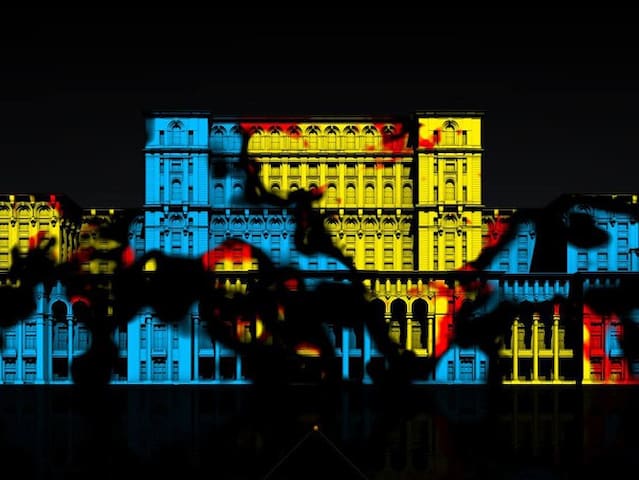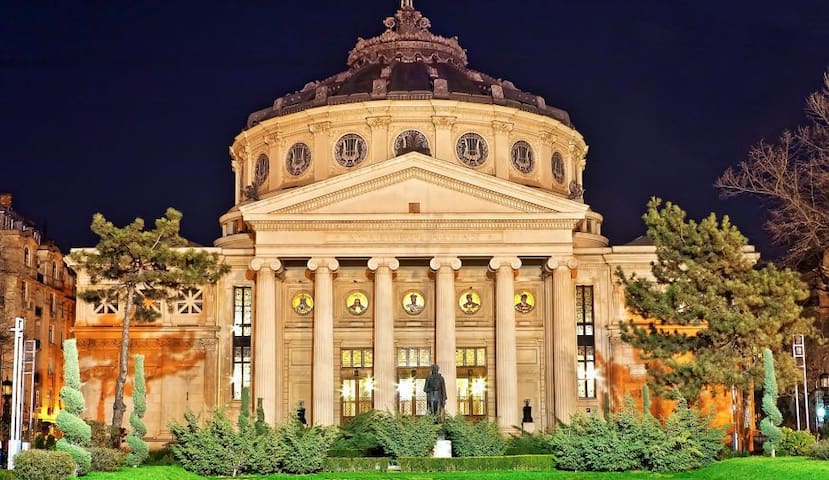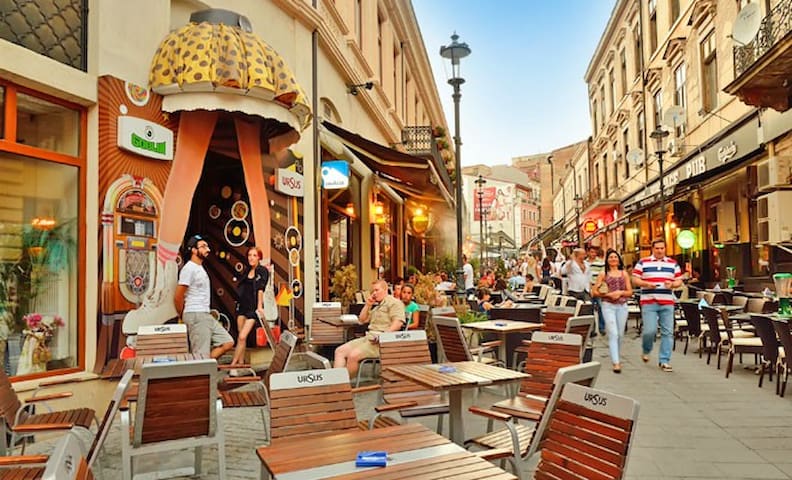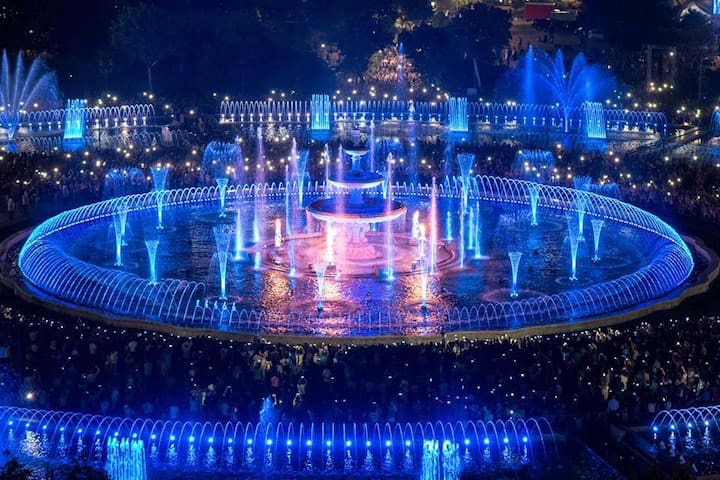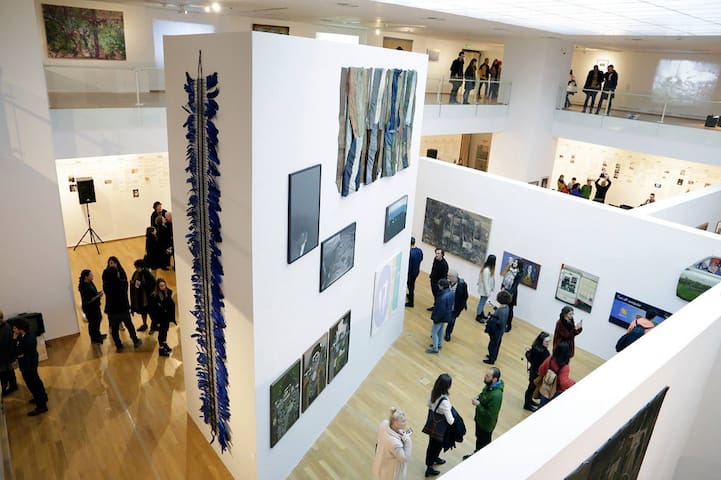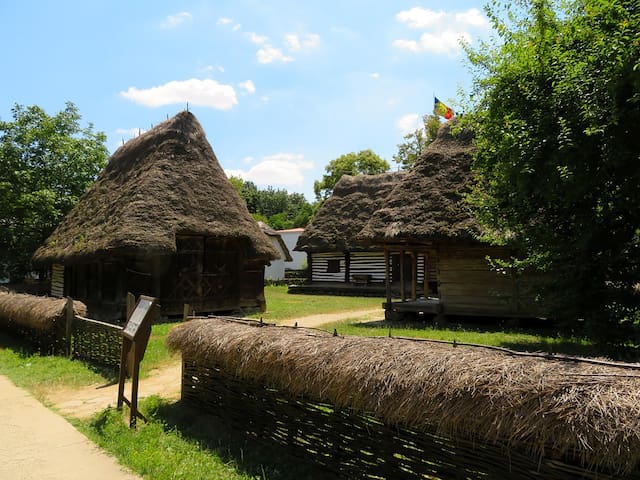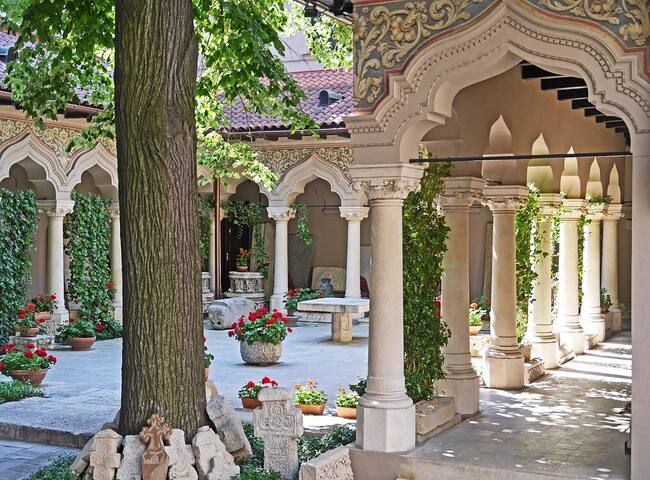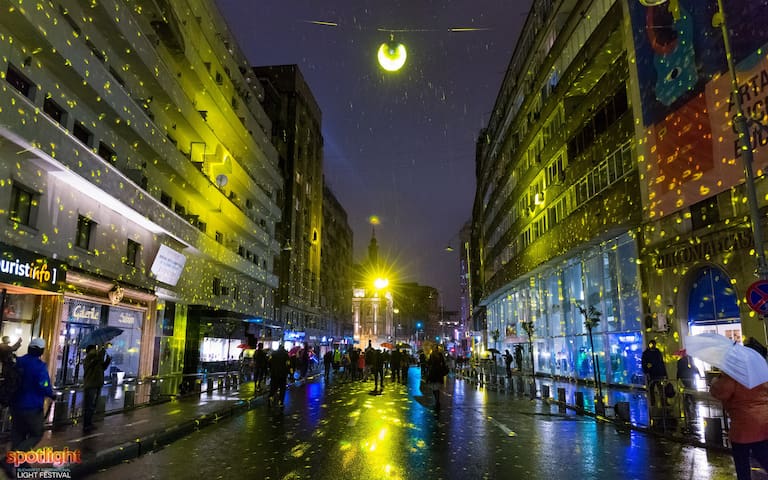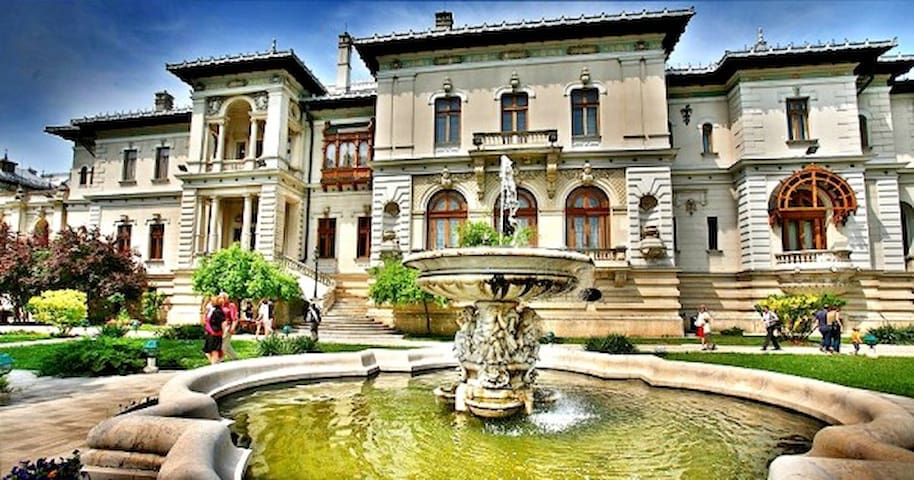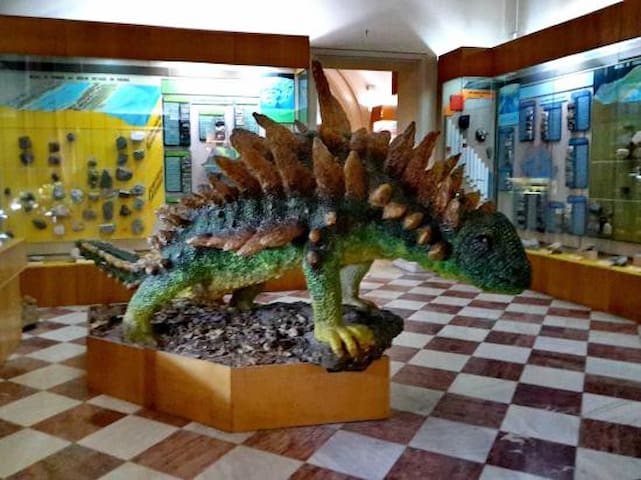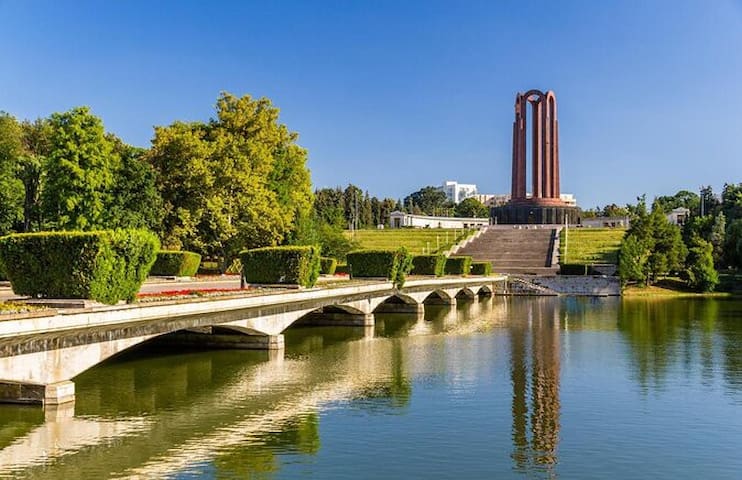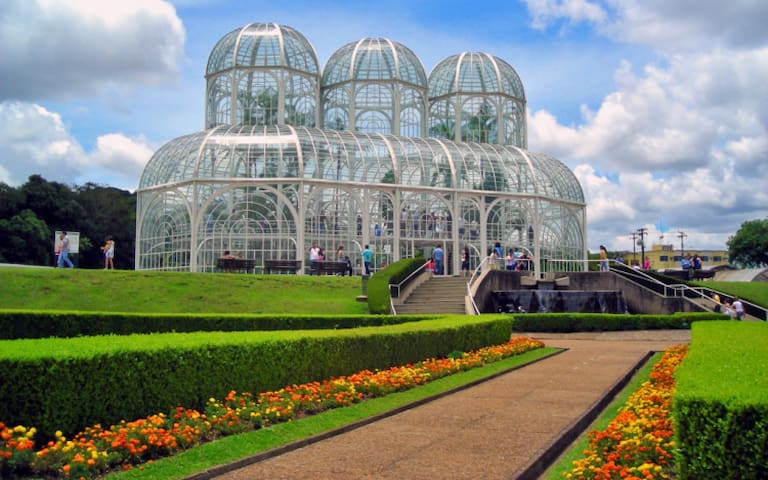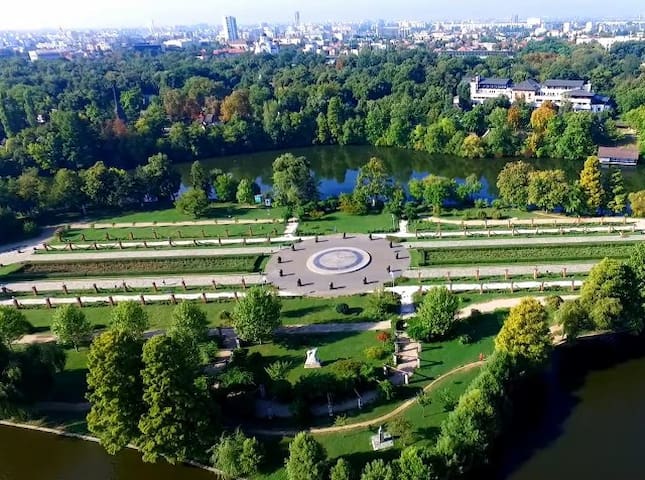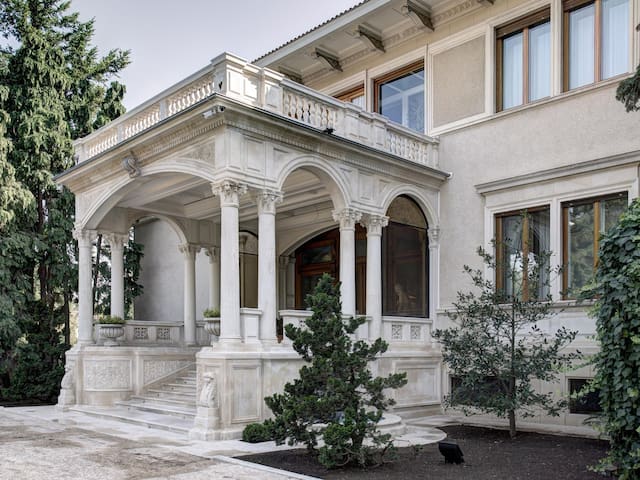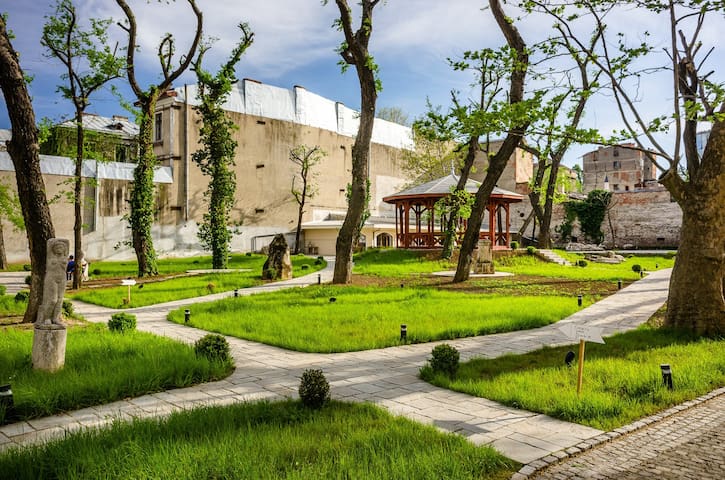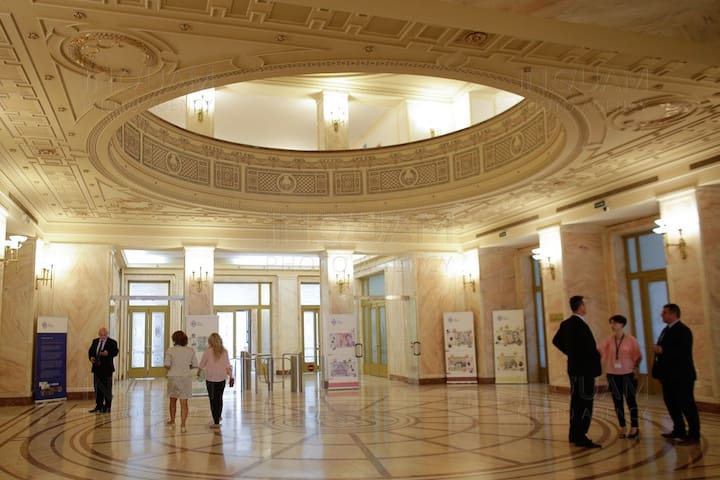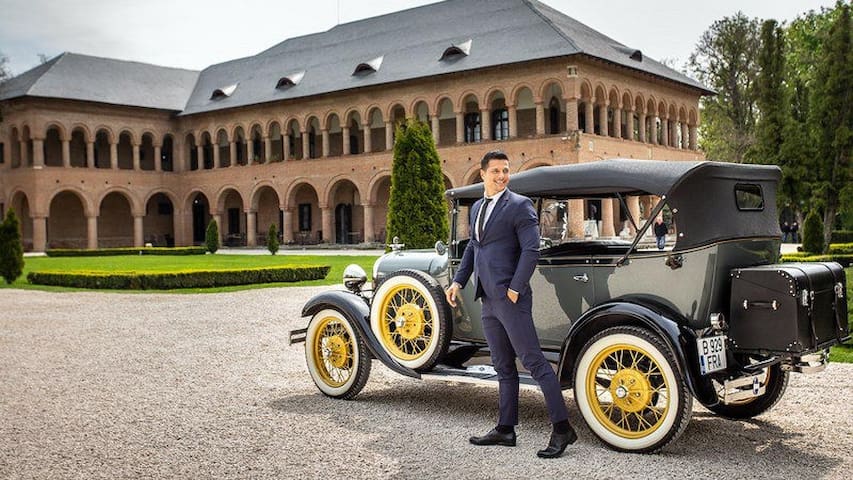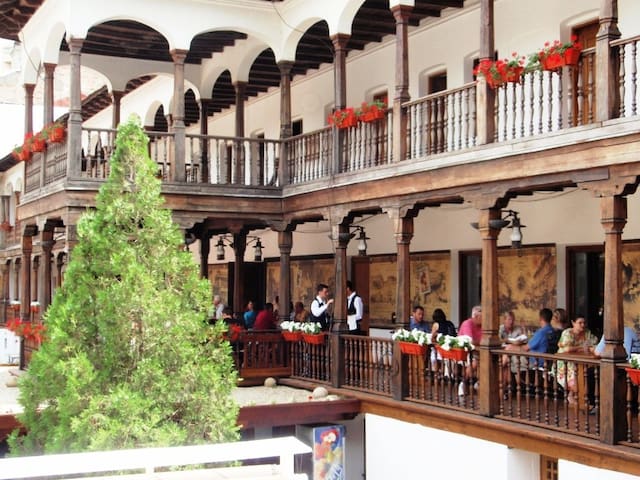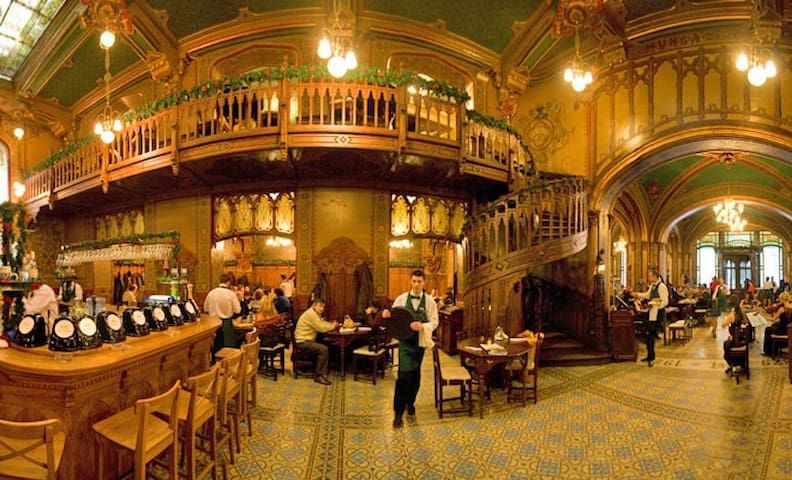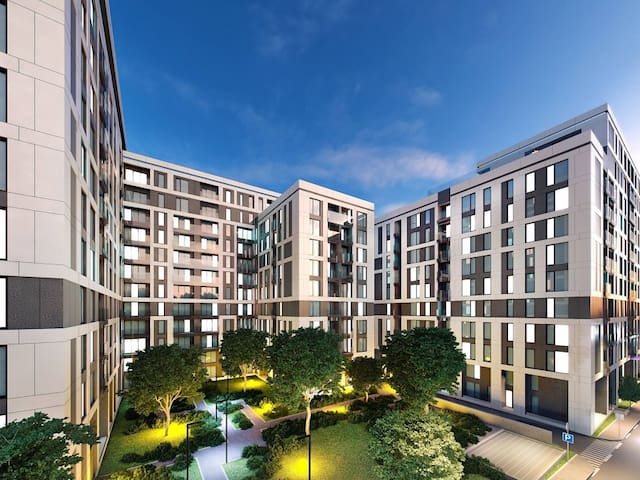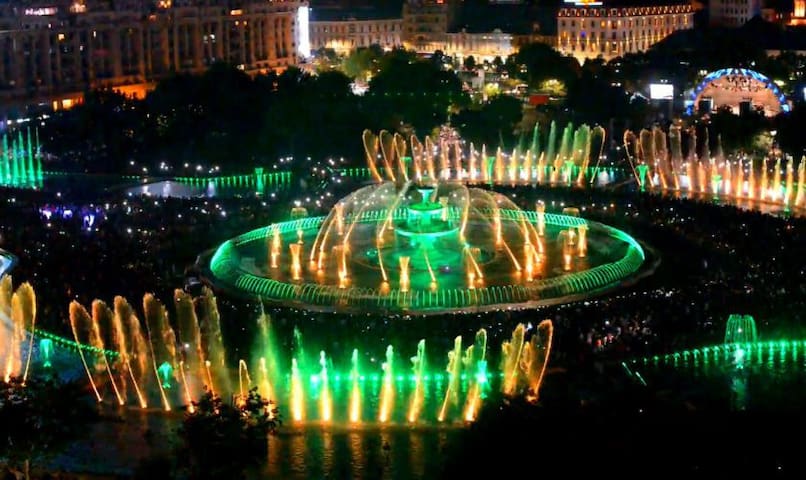City/town information
The capital of Romania has lots of charming lanes through the Old Town which will make you discover the history on every step. It’s dynamically growing city as well as important commercial and industrial center. Wandering what is Bucharest famous for you need to know, that between mixture of building from different centuries there are many hidden cafés, forgotten architectural gems on tucked away corners. This makes the city of Bucharest unique.
64 recommandé par les habitants
Bucharest
The capital of Romania has lots of charming lanes through the Old Town which will make you discover the history on every step. It’s dynamically growing city as well as important commercial and industrial center. Wandering what is Bucharest famous for you need to know, that between mixture of building from different centuries there are many hidden cafés, forgotten architectural gems on tucked away corners. This makes the city of Bucharest unique.
Vizitarea obiectivelor turistice
There’s a good reason why everyone wants to see this building when traveling to Bucharest! Also named the House of the People, The Palace of the Parliament is the heaviest building in the world and the second largest and most expensive administrative building, right after the Pentagon. The Palace was ordered by Nicolae Ceaușescu, the dictator of Communist Romania, and it houses the Parliament of Romania along with three museums and an international conference centre. If you want to find out how much it weights and other interesting facts about it, we suggest visiting this place.
35 recommandé par les habitants
Palatul Parlamentului station
Calea 13 SeptembrieThere’s a good reason why everyone wants to see this building when traveling to Bucharest! Also named the House of the People, The Palace of the Parliament is the heaviest building in the world and the second largest and most expensive administrative building, right after the Pentagon. The Palace was ordered by Nicolae Ceaușescu, the dictator of Communist Romania, and it houses the Parliament of Romania along with three museums and an international conference centre. If you want to find out how much it weights and other interesting facts about it, we suggest visiting this place.
Built after the French model, the Arch of Triumph in “Little Paris,” as some used to call the Romanian capital city, is the “little brother” of the famous monument of the same name in Paris. The Arch of Triumph is a historic landmark of Bucharest and a symbol of the city. Alongside the Mausoleum of Mărășești, the Heroes’ Cross on the Caraiman Peak and the Mausoleum and the Tomb of the Unknown Hero in Bucharest’s Carol Park, the Arch of Triumph commemorates Romania's participation in the World War I on the side of the Allied powers.
Arcul de Triumf
Built after the French model, the Arch of Triumph in “Little Paris,” as some used to call the Romanian capital city, is the “little brother” of the famous monument of the same name in Paris. The Arch of Triumph is a historic landmark of Bucharest and a symbol of the city. Alongside the Mausoleum of Mărășești, the Heroes’ Cross on the Caraiman Peak and the Mausoleum and the Tomb of the Unknown Hero in Bucharest’s Carol Park, the Arch of Triumph commemorates Romania's participation in the World War I on the side of the Allied powers.
The exquisite Athenaeum is the majestic heart of Romania’s classical-music tradition. Scenes from Romanian history are featured on the interior fresco inside the Big Hall on the 1st floor; the dome is 41m high. A huge appeal dubbed ‘Give a Penny for the Athenaeum’ saved it from disaster after funds dried up in the late 19th century. Today it’s home to the George Enescu Philharmonic Orchestra and normally only open during concerts, but you can often take a peek inside.
The peristyle is adorned with mosaics of five Romanian rulers, including Moldavian prince Vasile Lupu (r 1512–21), Wallachian Matei Basarab (r 1632–54) and King Carol I (r 1881–1914). It was built in 1888, and George Enescu made his debut here in 1898, followed five years later by the first performance of his masterpiece, Romanian Rhapsody.
333 recommandé par les habitants
Romanian Athenaeum
1-3 Strada Benjamin FranklinThe exquisite Athenaeum is the majestic heart of Romania’s classical-music tradition. Scenes from Romanian history are featured on the interior fresco inside the Big Hall on the 1st floor; the dome is 41m high. A huge appeal dubbed ‘Give a Penny for the Athenaeum’ saved it from disaster after funds dried up in the late 19th century. Today it’s home to the George Enescu Philharmonic Orchestra and normally only open during concerts, but you can often take a peek inside.
The peristyle is adorned with mosaics of five Romanian rulers, including Moldavian prince Vasile Lupu (r 1512–21), Wallachian Matei Basarab (r 1632–54) and King Carol I (r 1881–1914). It was built in 1888, and George Enescu made his debut here in 1898, followed five years later by the first performance of his masterpiece, Romanian Rhapsody.
The Historical Center of Bucharest, or the Old Town, as it is called by the locals, is one of the most beloved and attractive areas in Bucharest, a place steeped in buildings built in neoclassical and neo-baroque style. Many of these buildings have on the ground floor terraces, cafes, restaurants, and shops, full of foreign tourists, but also locals, most of the year.
The Old Town in Bucharest is a beautiful place to visit. The architecture is wonderful, there are many old buildings to see and lots of shops and restaurants which worth a visit while in Bucharest.
You can walk into the Old Town from just about anywhere in central Bucharest. If coming from further afield, take the metro to either Piata Unirii or Universitate.
Bucharest Old Town has so many good bars and clubs, restaurants, friendly people and it`s the perfect place to make beautiful memories. Also, you can enjoy a variety of restaurants and coffee shops, and lounges, especially better in warm weather at decent prices. During the night you can have a lot of fun in a pub, in a club or simply wandering through the streets.
556 recommandé par les habitants
Old Town
The Historical Center of Bucharest, or the Old Town, as it is called by the locals, is one of the most beloved and attractive areas in Bucharest, a place steeped in buildings built in neoclassical and neo-baroque style. Many of these buildings have on the ground floor terraces, cafes, restaurants, and shops, full of foreign tourists, but also locals, most of the year.
The Old Town in Bucharest is a beautiful place to visit. The architecture is wonderful, there are many old buildings to see and lots of shops and restaurants which worth a visit while in Bucharest.
You can walk into the Old Town from just about anywhere in central Bucharest. If coming from further afield, take the metro to either Piata Unirii or Universitate.
Bucharest Old Town has so many good bars and clubs, restaurants, friendly people and it`s the perfect place to make beautiful memories. Also, you can enjoy a variety of restaurants and coffee shops, and lounges, especially better in warm weather at decent prices. During the night you can have a lot of fun in a pub, in a club or simply wandering through the streets.
The World Record Academy has recognized the recently re-designed fountains in Bucharest’s Unirii Square as “the longest choreographed fountain system” in the world.
Unirii Square in Bucharest is the very center of the Romanian Capital. The Olt Town is next to it, also the University Square and The Palace of Parliament.
There are more than 20 fountains in Unification Square, the Central one being called Bucur’s fountain, for the legend says it was the shepherd Bucur who founded Bucharest. In fact, Bucur built in the beginning of the 14th century, a small church near a river( Dambovita) where he found food enough for his sheep. Around this small church, people started to build houses and a new village came into being.
Unirea Shopping Center, a symbol of the new city, is now a very visited shopping destination, housing Zara, Mc Donnald’s, Bershka, H&M, Leonardo and so on. It is 84.000 square meters.
68 recommandé par les habitants
piața Unirii
The World Record Academy has recognized the recently re-designed fountains in Bucharest’s Unirii Square as “the longest choreographed fountain system” in the world.
Unirii Square in Bucharest is the very center of the Romanian Capital. The Olt Town is next to it, also the University Square and The Palace of Parliament.
There are more than 20 fountains in Unification Square, the Central one being called Bucur’s fountain, for the legend says it was the shepherd Bucur who founded Bucharest. In fact, Bucur built in the beginning of the 14th century, a small church near a river( Dambovita) where he found food enough for his sheep. Around this small church, people started to build houses and a new village came into being.
Unirea Shopping Center, a symbol of the new city, is now a very visited shopping destination, housing Zara, Mc Donnald’s, Bershka, H&M, Leonardo and so on. It is 84.000 square meters.
The National Museum of Art of Romania is an art museum in Bucharest that is housed in the Royal Palace in Revolution Square. The museum holds collections of medieval and modern Romanian art and international art pieces collected by the royal family of Romania. The museum is divided into 3 galleries, namely: The European Art Gallery (with Romania’s premier collection of European art), the Romanian Medieval Art Gallery (with over 900 icons, mural paintings, embroideries, manuscripts, silverware and woodcarvings) and the Romanian Modern Art Gallery (where the story is told of Romanian art from the mid-nineteenth to the late twentieth century).
276 recommandé par les habitants
The National Museum of Art of Romania
49-53 Calea VictorieiThe National Museum of Art of Romania is an art museum in Bucharest that is housed in the Royal Palace in Revolution Square. The museum holds collections of medieval and modern Romanian art and international art pieces collected by the royal family of Romania. The museum is divided into 3 galleries, namely: The European Art Gallery (with Romania’s premier collection of European art), the Romanian Medieval Art Gallery (with over 900 icons, mural paintings, embroideries, manuscripts, silverware and woodcarvings) and the Romanian Modern Art Gallery (where the story is told of Romanian art from the mid-nineteenth to the late twentieth century).
If you find yourself among the people interested in finding out more about the evolution of folk art, then we suggest you add, on the list of sights to be visited in Bucharest, the Romanian Peasant Museum. This attraction includes the richest collection of traditional objects in Romania, where tourists can admire ceramics exhibitions, fabrics, folk costumes, sculpted objects, furniture, and icons. For those of you who are curious to find out more about art during the communist regime, we suggest you visit the Museum of Communist Iconography, located inside the Romanian Peasant Museum.
The National Museum of the Romanian Peasant, established on February 5, 1990, is the continuation of some museum traditions dating back to 1875, when the first section of textile art with "works done in the country" was constituted, next to the National Museum of Antiquity. The building, an illustration of the Neo-Romanian style inspired by the Brancovian tradition, arranged in the form of monastic type enclosures, was completed in 1941, taking the appearance of the present architectural monument that is the headquarters of the National Museum of the Romanian Peasant.
20 recommandé par les habitants
Muzeul Ţăranului Român
If you find yourself among the people interested in finding out more about the evolution of folk art, then we suggest you add, on the list of sights to be visited in Bucharest, the Romanian Peasant Museum. This attraction includes the richest collection of traditional objects in Romania, where tourists can admire ceramics exhibitions, fabrics, folk costumes, sculpted objects, furniture, and icons. For those of you who are curious to find out more about art during the communist regime, we suggest you visit the Museum of Communist Iconography, located inside the Romanian Peasant Museum.
The National Museum of the Romanian Peasant, established on February 5, 1990, is the continuation of some museum traditions dating back to 1875, when the first section of textile art with "works done in the country" was constituted, next to the National Museum of Antiquity. The building, an illustration of the Neo-Romanian style inspired by the Brancovian tradition, arranged in the form of monastic type enclosures, was completed in 1941, taking the appearance of the present architectural monument that is the headquarters of the National Museum of the Romanian Peasant.
Would you dare lie on a bed of nails? How about turning yourself into a delicious snack? It's a wacky world over at the Museum of Senses Bucharest, designed to let you smell, touch, taste, see, and hear your way around its many mind-boggling rooms.
Ignite your senses as you explore over 40 different exhibits in multiple zones. It's a journey of deception, perception and play, with a healthy blend of education and optical illusions.
20 recommandé par les habitants
Museum of Senses Bucharest
4 Bd. G-ral Vasile MileaWould you dare lie on a bed of nails? How about turning yourself into a delicious snack? It's a wacky world over at the Museum of Senses Bucharest, designed to let you smell, touch, taste, see, and hear your way around its many mind-boggling rooms.
Ignite your senses as you explore over 40 different exhibits in multiple zones. It's a journey of deception, perception and play, with a healthy blend of education and optical illusions.
Packed with exhibits (including the obligatory Jurassic skeletons), the Antipa will keep kids of all ages - and their parents - occupied for a good couple of hours. There are all sorts of hands-on, interactive displays, as well as 3D films, artificial caves and - in the basement - a thorough guide to the incredible amount of animal and plant life native to Romania. The building which houses it all is itself worthy of note, purpose built in 1908 at the behest of Grigore Antipa, a noted Romanian naturalist who then set-up and ran the museum for almost five decades until his death in 1944.
Discover the diverse wildlife of past and present Romania via touchscreens, games, dioramas, 3-D films, and interactive exhibits at Grigore Antipa National Museum of Natural History. The museum features collections of invertebrate and vertebrate animal groups, fossils, minerals, and rocks, as well as displays relating to ethnography, anthropology, comparative anatomy, and geology. See the life-size models of living and extinct animals in the recreation of their ecosystems. Dinosaur skeletons and an artificial cave will keep kids of all ages busy.
279 recommandé par les habitants
Antipa Museum
1 Şoseaua Pavel D. KiseleffPacked with exhibits (including the obligatory Jurassic skeletons), the Antipa will keep kids of all ages - and their parents - occupied for a good couple of hours. There are all sorts of hands-on, interactive displays, as well as 3D films, artificial caves and - in the basement - a thorough guide to the incredible amount of animal and plant life native to Romania. The building which houses it all is itself worthy of note, purpose built in 1908 at the behest of Grigore Antipa, a noted Romanian naturalist who then set-up and ran the museum for almost five decades until his death in 1944.
Discover the diverse wildlife of past and present Romania via touchscreens, games, dioramas, 3-D films, and interactive exhibits at Grigore Antipa National Museum of Natural History. The museum features collections of invertebrate and vertebrate animal groups, fossils, minerals, and rocks, as well as displays relating to ethnography, anthropology, comparative anatomy, and geology. See the life-size models of living and extinct animals in the recreation of their ecosystems. Dinosaur skeletons and an artificial cave will keep kids of all ages busy.
The Coral Temple is the main synagogue in Bucharest and one of the few active synagogues in the country. It was built in 1866 according to the design of Enderle and Freiwald. Its architecture resembles the Tempelgasse synagogue in Vienna, designed by Ludwig Förster ten years earlier.
The synagogue consists of four floors, including one underground. It is 32 m long, 14 m wide and 32 m high. Its façade is decorated with bricks in two colors. It is worth paying attention to the entrance portal built in the Moorish style.
10 recommandé par les habitants
Coral Temple
9-11 Strada Sfânta VineriThe Coral Temple is the main synagogue in Bucharest and one of the few active synagogues in the country. It was built in 1866 according to the design of Enderle and Freiwald. Its architecture resembles the Tempelgasse synagogue in Vienna, designed by Ludwig Förster ten years earlier.
The synagogue consists of four floors, including one underground. It is 32 m long, 14 m wide and 32 m high. Its façade is decorated with bricks in two colors. It is worth paying attention to the entrance portal built in the Moorish style.
Looking out for what can you do with kids and family in Bucharest? Here are the things that you should not miss out on a family vacation with kids, toddlers, or babies. Discover the ultimate places for kids in Bucharest, be it water parks, theme parks, or playgrounds. Children will have fun, learn new things, get good food and will not get bored in long queues.
21 recommandé par les habitants
Children's Town Bucharest
Looking out for what can you do with kids and family in Bucharest? Here are the things that you should not miss out on a family vacation with kids, toddlers, or babies. Discover the ultimate places for kids in Bucharest, be it water parks, theme parks, or playgrounds. Children will have fun, learn new things, get good food and will not get bored in long queues.
This is the city's most historically famous and beautiful street. It became famous when in the 17th century it was paved over with wood. The reason for this was during rainy seasons, especially spring or autumn, roads leading to the Balkan areas would become extremely muddy, but not this street. By the eighteenth century this was one of the most fashionable areas in the city. It has lived up to this reputation today - B&R Avenue is lined with upscale bars, boutiques, characters, restaurants and other stores. In essence it is an upscale shopping strip.
30 recommandé par les habitants
Calea Victoriei
Calea VictorieiThis is the city's most historically famous and beautiful street. It became famous when in the 17th century it was paved over with wood. The reason for this was during rainy seasons, especially spring or autumn, roads leading to the Balkan areas would become extremely muddy, but not this street. By the eighteenth century this was one of the most fashionable areas in the city. It has lived up to this reputation today - B&R Avenue is lined with upscale bars, boutiques, characters, restaurants and other stores. In essence it is an upscale shopping strip.
This is the official residence of the president of Romania and also the location of the the National Cotroceni Museum. The first building on the site was a monastery built in the seventeenth Century. Later the area became the favored location of the Royal Family. Carol I of Romania ordered a palace to be built on the site. Under communist rule the palace was known as a center to inculcate children into communist ideology. The Communist rule also saw much of the palace being renovated and much of its old interior decor was destroyed. The originals church is still standing. The only way to see the areas of the palace is by guided tour. The surrounding wooded areas are quite pretty.
44 recommandé par les habitants
Cotroceni National Museum
1-3 Bulevardul GeniuluiThis is the official residence of the president of Romania and also the location of the the National Cotroceni Museum. The first building on the site was a monastery built in the seventeenth Century. Later the area became the favored location of the Royal Family. Carol I of Romania ordered a palace to be built on the site. Under communist rule the palace was known as a center to inculcate children into communist ideology. The Communist rule also saw much of the palace being renovated and much of its old interior decor was destroyed. The originals church is still standing. The only way to see the areas of the palace is by guided tour. The surrounding wooded areas are quite pretty.
Although many seem to think that this is indeed the house of George Enescu, it is not. The house was formerly owned by the landowner George Cantacuzin. It was not until 1956, one year after George Enescu's death, that the house was converted into a museum dedicated to his life and art. If you don't know, George Enescu was one of Romania's foremost composers in his time. The house is not only filled with memorabilia from his life (musical instruments, photographs, manuscripts, documents)and exhibitions of his work, but also provides a valuable insight into Romanian music history. The palace is one of the most beautiful buildings in the city.
35 recommandé par les habitants
George Enescu National Museum
141 Calea VictorieiAlthough many seem to think that this is indeed the house of George Enescu, it is not. The house was formerly owned by the landowner George Cantacuzin. It was not until 1956, one year after George Enescu's death, that the house was converted into a museum dedicated to his life and art. If you don't know, George Enescu was one of Romania's foremost composers in his time. The house is not only filled with memorabilia from his life (musical instruments, photographs, manuscripts, documents)and exhibitions of his work, but also provides a valuable insight into Romanian music history. The palace is one of the most beautiful buildings in the city.
The first museum in this stately building, about 100 years ago, occupied only the basement. That collection has now expanded to fill 22 rooms. There are 14 main exhibitions cover about 45000 specimens that explore planet formation, plate tectonics, minerals and their uses, the emergence of human life, paleozoology, paleobotany, as well as a comprehensive geologic history of Romania itself. Specimens at the museum include some of the oldest rocks (1.5 billion years old), and oldest known samples of life (600 million years old).
28 recommandé par les habitants
Muzeul National de Geologie
2 Şoseaua Pavel D. KiseleffThe first museum in this stately building, about 100 years ago, occupied only the basement. That collection has now expanded to fill 22 rooms. There are 14 main exhibitions cover about 45000 specimens that explore planet formation, plate tectonics, minerals and their uses, the emergence of human life, paleozoology, paleobotany, as well as a comprehensive geologic history of Romania itself. Specimens at the museum include some of the oldest rocks (1.5 billion years old), and oldest known samples of life (600 million years old).
This store is squarely aimed at tourists. It's a souvenir and gift shop, and practically a one stop location for all of your Bucharest souvenir shopping. Yes, there are other memorabilia that you cannot find here, but for a tourist looking to hurriedly purchase things to take back home there is nowhere else to go. Clothes, fridge magnets, mugs, key-chains, chocolates, confectioneries, kitchenware, handicraft, ceramics, postcards - all of it wonderfully and authentically Romanian. In addition to their normal merchandise they also offer printing and decorating services. The staff is extremely helpful.
6 recommandé par les habitants
Romanian Boutique
27 Strada BărățieiThis store is squarely aimed at tourists. It's a souvenir and gift shop, and practically a one stop location for all of your Bucharest souvenir shopping. Yes, there are other memorabilia that you cannot find here, but for a tourist looking to hurriedly purchase things to take back home there is nowhere else to go. Clothes, fridge magnets, mugs, key-chains, chocolates, confectioneries, kitchenware, handicraft, ceramics, postcards - all of it wonderfully and authentically Romanian. In addition to their normal merchandise they also offer printing and decorating services. The staff is extremely helpful.
The old princely court isn't nearly as impressive to look at as the nearby Curtea Veche Church. But as far as sheer mystique goes, it's much more interesting. You see, the palace was built in 1459 on the orders of Vlad the Impaler, who is known in popular culture as Dracula. At the time, the palace was the economic centre of the city. Today, after the fire and earthquake in the 18th century, only ruins remain. Excavations in 1953 unearthed these ruins, an area of 25,000 square metres. Still visible on site today are the water supply system, the Turkish bath palace, exterior architectural flourishes, and some of the interior murals.
27 recommandé par les habitants
Curtea Veche
25 Str. FrancezăThe old princely court isn't nearly as impressive to look at as the nearby Curtea Veche Church. But as far as sheer mystique goes, it's much more interesting. You see, the palace was built in 1459 on the orders of Vlad the Impaler, who is known in popular culture as Dracula. At the time, the palace was the economic centre of the city. Today, after the fire and earthquake in the 18th century, only ruins remain. Excavations in 1953 unearthed these ruins, an area of 25,000 square metres. Still visible on site today are the water supply system, the Turkish bath palace, exterior architectural flourishes, and some of the interior murals.
Located in the district of Baneasa in the northern part of the city, the Bucharest Zoo was established in 1955. Its 5.85 hectares are home to about 800 animals covering about 100 species. Tigers, lynxes, wolves, bears, lemurs, pumas, iguanas, snakes, poison frogs and a crocodile are some of the standard fare. You'll also find some goats, bighorn sheep, a horse, zebras, deer, an ostrich, and an emu. Visitors especially love the tropical birds section.
18 recommandé par les habitants
Grădina Zoologică
Located in the district of Baneasa in the northern part of the city, the Bucharest Zoo was established in 1955. Its 5.85 hectares are home to about 800 animals covering about 100 species. Tigers, lynxes, wolves, bears, lemurs, pumas, iguanas, snakes, poison frogs and a crocodile are some of the standard fare. You'll also find some goats, bighorn sheep, a horse, zebras, deer, an ostrich, and an emu. Visitors especially love the tropical birds section.
Also known as Liberty Park, this park doubles as a historical monument in remembrance of socialist militants. It is famous for the tree-lined esplanade that courses through and around it's shimmering lake. Altogether it comprises of about 30 acres worth of landscaped gardens. Check out the elegant and solemn Mausoleum, a World War 1 Monument which was originally a communist monument. There's also the small Tepes Castle on the grounds from the early 20th century. Scattered around are various statues of historical figures. Other sites of interest include the Gogu Constantinescu bridge, the Giants' Statues, the statue of Sleeping Beauty, and the open-air Roman Arena which is used for musical concerts.
31 recommandé par les habitants
Parcul Carol
Also known as Liberty Park, this park doubles as a historical monument in remembrance of socialist militants. It is famous for the tree-lined esplanade that courses through and around it's shimmering lake. Altogether it comprises of about 30 acres worth of landscaped gardens. Check out the elegant and solemn Mausoleum, a World War 1 Monument which was originally a communist monument. There's also the small Tepes Castle on the grounds from the early 20th century. Scattered around are various statues of historical figures. Other sites of interest include the Gogu Constantinescu bridge, the Giants' Statues, the statue of Sleeping Beauty, and the open-air Roman Arena which is used for musical concerts.
Established in 1860, this century and a half old botanical garden has slowly and steadily built a respectable reputation for itself. Though damaged in WWII bombings, the 17.5 hectare garden now has over 10000 species of plants - decoratives, rare species, Mediterranean flowers, Italian flora, roses, iris, and medicinal. The greenhouses, a separate section, house plants from all over the world in climate controlled environments. In addition to tourism, the garden also generates great research interest. It is affiliated to the university, and it's Romanian Brancovenesc-style museum is fascinating. There's also a library of over 9000 volumes on botany.
38 recommandé par les habitants
Gradina Botanica station
Established in 1860, this century and a half old botanical garden has slowly and steadily built a respectable reputation for itself. Though damaged in WWII bombings, the 17.5 hectare garden now has over 10000 species of plants - decoratives, rare species, Mediterranean flowers, Italian flora, roses, iris, and medicinal. The greenhouses, a separate section, house plants from all over the world in climate controlled environments. In addition to tourism, the garden also generates great research interest. It is affiliated to the university, and it's Romanian Brancovenesc-style museum is fascinating. There's also a library of over 9000 volumes on botany.
The museum 60 exhibition rooms cover Romanian history from prehistoric to Modern Times. There is special emphasis on the Dacian period, The transformation of culture under Roman rule, the revolution of 1848, and Romania under Russian rule.
The three artifacts that people mostly come here to see are:
A plaster cast of Trajan's column (Commemorating the Roman emperor's victory over the Dacian kingdom).
Pietroasele Treasure- 22 golden objects from the 4th century, Of which only 12 survive.
The Romanian crown jewels
The architecture is pretty eclectic - Doric columns on the facade and plentiful allegorical sculptures.
256 recommandé par les habitants
Muzeul National de Istorie a Romaniei
12 Calea VictorieiThe museum 60 exhibition rooms cover Romanian history from prehistoric to Modern Times. There is special emphasis on the Dacian period, The transformation of culture under Roman rule, the revolution of 1848, and Romania under Russian rule.
The three artifacts that people mostly come here to see are:
A plaster cast of Trajan's column (Commemorating the Roman emperor's victory over the Dacian kingdom).
Pietroasele Treasure- 22 golden objects from the 4th century, Of which only 12 survive.
The Romanian crown jewels
The architecture is pretty eclectic - Doric columns on the facade and plentiful allegorical sculptures.
Almost 70% of this park comprises of Herastrau Lake, around which the wooded areas grow. Before we speak of the park's recreational opportunities, you should know that human settlement has been discovered in this park that dates back to the Paleolithic era. Bones of the extinct woolly mammoth have been found here. Also found are coins from the first century BC parts to be from the Dacian settlements of Herastrau.
Sunday afternoons, most of the city's residents retreat to this park for leisure, and yet it never feels crowded. Check out the bronze statue of Charles de Gaulle, widely known as the third ugliest statue in the city. There are also statues of other historical figures everywhere. There's an Adventure Park for kids with trails of various difficulties. there's an aquarium with hundreds of marine animals and plants. There is an open-air Summer Amphitheater. Close to the Hard Rock Cafe there will be a jetty from which boat trips can be taken out into the water. Check out the gorgeous Island of the Roses. A 6 kilometers cycling and jogging track circles the lake; during summertime cycles can be rented from the park entrance.
435 recommandé par les habitants
King Mihai I Park
Almost 70% of this park comprises of Herastrau Lake, around which the wooded areas grow. Before we speak of the park's recreational opportunities, you should know that human settlement has been discovered in this park that dates back to the Paleolithic era. Bones of the extinct woolly mammoth have been found here. Also found are coins from the first century BC parts to be from the Dacian settlements of Herastrau.
Sunday afternoons, most of the city's residents retreat to this park for leisure, and yet it never feels crowded. Check out the bronze statue of Charles de Gaulle, widely known as the third ugliest statue in the city. There are also statues of other historical figures everywhere. There's an Adventure Park for kids with trails of various difficulties. there's an aquarium with hundreds of marine animals and plants. There is an open-air Summer Amphitheater. Close to the Hard Rock Cafe there will be a jetty from which boat trips can be taken out into the water. Check out the gorgeous Island of the Roses. A 6 kilometers cycling and jogging track circles the lake; during summertime cycles can be rented from the park entrance.
The “Ceauşescu Mansion” was for a quarter of a century (1965-1989) the private residence of Nicolae and Elena Ceauşescu and of their children, Nicu, Zoia, and Valentin.
Built in the mid-1960s and known at the time as the “Spring Palace”, the mansion was enlarged between 1970 and 1972. The preferred choice for the design of the Ceauşescu family’s residence was Aron Grimberg-Solari (born 1928). The architecture of the palace is complemented by landscaping conceived by the architect Robert Woll (who was also the main furniture designer for the house) and the landscape engineer Teodosiu.
The spatial qualities and balanced volumes of the Ceaușescu Mansion are striking, as is its luxurious and comfortable interior, the work of the architects Robert Woll and Agrippa Popescu.
44 recommandé par les habitants
House of Ceauşescu
50 Bulevardul PrimăveriiThe “Ceauşescu Mansion” was for a quarter of a century (1965-1989) the private residence of Nicolae and Elena Ceauşescu and of their children, Nicu, Zoia, and Valentin.
Built in the mid-1960s and known at the time as the “Spring Palace”, the mansion was enlarged between 1970 and 1972. The preferred choice for the design of the Ceauşescu family’s residence was Aron Grimberg-Solari (born 1928). The architecture of the palace is complemented by landscaping conceived by the architect Robert Woll (who was also the main furniture designer for the house) and the landscape engineer Teodosiu.
The spatial qualities and balanced volumes of the Ceaușescu Mansion are striking, as is its luxurious and comfortable interior, the work of the architects Robert Woll and Agrippa Popescu.
A must-see attraction that should be included in any Bucharest City Guide is the House of the Free Press. A monument that is impressive through its architecture and history as well.
If you’d go back in time to 1905 on the site of what is now the House of Free Press, you’d find a horse racing track. The track was built by Romania’s King Carol I and was the main entertainment point.
Then under the communist regime, a third of the track was removed in 1950 when the first wing of the building was built. The whole racetrack was closed in 1960, by an order of Gheorghe Gheorghiu-Dej who was governing Romania at the time.
The building’s architectural elements are also a good reason for it to be included in the Bucharest City Guide. Besides the basic Soviet architecture, it also has details that are typical to the religious architecture cultivated in Wallachia and Moldavia.
Even today there are still socialist elements on the building. Some of the elements you’ll get to see for yourself if you book the “Last Days of Communism” tour, are:
The sickle and the hammer, the symbol of the Communist Party,
The Socialist Star
Elements that present the science and knowledge of the people
The resemblance of the building to gigantic industrial factories.
After the revolution, the sickle and hammer symbol has been taken down from most of the buildings, this being one of the few places it survived.
12 recommandé par les habitants
Casa Presei Libere
1 Piața Presei LibereA must-see attraction that should be included in any Bucharest City Guide is the House of the Free Press. A monument that is impressive through its architecture and history as well.
If you’d go back in time to 1905 on the site of what is now the House of Free Press, you’d find a horse racing track. The track was built by Romania’s King Carol I and was the main entertainment point.
Then under the communist regime, a third of the track was removed in 1950 when the first wing of the building was built. The whole racetrack was closed in 1960, by an order of Gheorghe Gheorghiu-Dej who was governing Romania at the time.
The building’s architectural elements are also a good reason for it to be included in the Bucharest City Guide. Besides the basic Soviet architecture, it also has details that are typical to the religious architecture cultivated in Wallachia and Moldavia.
Even today there are still socialist elements on the building. Some of the elements you’ll get to see for yourself if you book the “Last Days of Communism” tour, are:
The sickle and the hammer, the symbol of the Communist Party,
The Socialist Star
Elements that present the science and knowledge of the people
The resemblance of the building to gigantic industrial factories.
After the revolution, the sickle and hammer symbol has been taken down from most of the buildings, this being one of the few places it survived.
Biggest aqua park in Romania Unique features, such as the slides variety, wave pool, sandy beach, private pavilions, changing rooms with showers and lockers,etc. Special care was paid to family attractions and the kids have their special pools, some with heated water. Various ways to reach us, including train, public bus and private buses.
10 recommandé par les habitants
Divertiland Water Park
1 Strada DivertismentuluiBiggest aqua park in Romania Unique features, such as the slides variety, wave pool, sandy beach, private pavilions, changing rooms with showers and lockers,etc. Special care was paid to family attractions and the kids have their special pools, some with heated water. Various ways to reach us, including train, public bus and private buses.
The main building is now open to the public, with a new base exhibition – The Museum of Ages. More on the exhibition can be found in the last paragraph of the present text. The garden is also open to visitors, hosting temporary exhibition and events when the weather is favorable. The Lapidarium will soon host a permanent exhibition dedicated to the frescos of the Văcăreşti Monastery, scheduled to open on the 24th of February 2017.
Near Piața Victoriei, at the crossing between Victoria Avenue and Sevastopol Street we can find the residence of Constantin Cesianu. Cesianu House (1892) is an example of the reconditioning of an older residence, from the period of 1846-1850 and is one of the few aristocratic residences of inter-bellum Bucharest which remains faithful to its original design.
6 recommandé par les habitants
Casa Filipescu Cesianu
151 Calea VictorieiThe main building is now open to the public, with a new base exhibition – The Museum of Ages. More on the exhibition can be found in the last paragraph of the present text. The garden is also open to visitors, hosting temporary exhibition and events when the weather is favorable. The Lapidarium will soon host a permanent exhibition dedicated to the frescos of the Văcăreşti Monastery, scheduled to open on the 24th of February 2017.
Near Piața Victoriei, at the crossing between Victoria Avenue and Sevastopol Street we can find the residence of Constantin Cesianu. Cesianu House (1892) is an example of the reconditioning of an older residence, from the period of 1846-1850 and is one of the few aristocratic residences of inter-bellum Bucharest which remains faithful to its original design.
Water Park Otopeni is the city of entertainment that covers an area of 40,000 square meters with a capacity of 5,000 people
8 recommandé par les habitants
Water Park Otopeni
255A Calea BucureștilorWater Park Otopeni is the city of entertainment that covers an area of 40,000 square meters with a capacity of 5,000 people
By visiting the Museum of the National Bank of Romania in the most beautiful building in Bucharest, as architect Ion Mincu used to say, you will discover:
-one of the most valuable numismatic collections in Romania, spanning two and a half millennia;
-the oldest coin minted on the territory of present-day Romania;
-the smallest paper money printed in Romania;
-the most numerous display of gold coins and medals;
-the history of the national currency from its beginnings to present times;
-interesting stories about two amazing buildings part of the national heritage;
-lesser known facts about the people that had run the National Bank;
-meaningful moments that had linked the activities of the National Bank to the history of Romania;
-unusual information about the characteristics and uses of gold.
A visit to the Museum of the National Bank of Romania is a unique and captivating journey through spaces filled with monetary, banking and cultural history. A visit to the Museum of the National Bank of Romania will give you the opportunity to enter a treasury of knowledge...
14 recommandé par les habitants
Museum of the National Bank of Romania
8 Strada DoamneiBy visiting the Museum of the National Bank of Romania in the most beautiful building in Bucharest, as architect Ion Mincu used to say, you will discover:
-one of the most valuable numismatic collections in Romania, spanning two and a half millennia;
-the oldest coin minted on the territory of present-day Romania;
-the smallest paper money printed in Romania;
-the most numerous display of gold coins and medals;
-the history of the national currency from its beginnings to present times;
-interesting stories about two amazing buildings part of the national heritage;
-lesser known facts about the people that had run the National Bank;
-meaningful moments that had linked the activities of the National Bank to the history of Romania;
-unusual information about the characteristics and uses of gold.
A visit to the Museum of the National Bank of Romania is a unique and captivating journey through spaces filled with monetary, banking and cultural history. A visit to the Museum of the National Bank of Romania will give you the opportunity to enter a treasury of knowledge...
The most central of the city's public gardens, Cismigiu is a haven of lawns, trees, flowers and lakes. Often mistakenly referred to as a park, Cismigiu is actually a large garden, first designed and laid out in 1845 by the German landscape architect Carl Meyer, but not completed until 1860. More than 30,000 trees and plants were brought in from the Romanian mountains, while exotic plants were fetched from the botanical gardens in Vienna. Highlights of the 17-hectare garden include the Roman Garden, laid out in the style of ancient Rome, and including busts of Romania's most famous writers, the lake, which can be explored by rowing boat in summer or skated upon during the winter, and Ion Jalea's French Memorial in Carrara marble, which commemorates those French troops killed on Romanian territory during World War I. The park has a couple of cafes, refreshment kiosks and - in summer - terraces, as well as some good, large children's playgrounds. It can get very busy in good weather, but it is a lovely place to spend time.
558 recommandé par les habitants
Cișmigiu Park
Bulevardul Regina ElisabetaThe most central of the city's public gardens, Cismigiu is a haven of lawns, trees, flowers and lakes. Often mistakenly referred to as a park, Cismigiu is actually a large garden, first designed and laid out in 1845 by the German landscape architect Carl Meyer, but not completed until 1860. More than 30,000 trees and plants were brought in from the Romanian mountains, while exotic plants were fetched from the botanical gardens in Vienna. Highlights of the 17-hectare garden include the Roman Garden, laid out in the style of ancient Rome, and including busts of Romania's most famous writers, the lake, which can be explored by rowing boat in summer or skated upon during the winter, and Ion Jalea's French Memorial in Carrara marble, which commemorates those French troops killed on Romanian territory during World War I. The park has a couple of cafes, refreshment kiosks and - in summer - terraces, as well as some good, large children's playgrounds. It can get very busy in good weather, but it is a lovely place to spend time.
Mogosoaia Palace easily passes as one of the most beautiful monuments around Bucharest. With a history that goes back more than 300 years, part of the lives of some great families, the palace and its vast gardens are an excellent weekend destination.
The story of Mogosoaia Palace begins in 1680, when a rich aristocrat, Constantin Brancoveanu, bought the large property in order to build a residence for his second son, Stefan. The palace was done by 1702 when Constantin Brancoveanu was already the prince of Southern Romania.
Extremely important for his role in the cultural development of the region, the rule of Constantin Brancoveanu ended tragically in 1714 when he was executed together with his four sons by the order of the Ottoman sultan. His legacy is astonishing even if today only a few of the many churches, monasteries, and palaces built during his time are still standing.
56 recommandé par les habitants
Mogosoaia Palace
Strada Constantin BrâncoveanuMogosoaia Palace easily passes as one of the most beautiful monuments around Bucharest. With a history that goes back more than 300 years, part of the lives of some great families, the palace and its vast gardens are an excellent weekend destination.
The story of Mogosoaia Palace begins in 1680, when a rich aristocrat, Constantin Brancoveanu, bought the large property in order to build a residence for his second son, Stefan. The palace was done by 1702 when Constantin Brancoveanu was already the prince of Southern Romania.
Extremely important for his role in the cultural development of the region, the rule of Constantin Brancoveanu ended tragically in 1714 when he was executed together with his four sons by the order of the Ottoman sultan. His legacy is astonishing even if today only a few of the many churches, monasteries, and palaces built during his time are still standing.
Scena culinară
The Linden Tree Inn is the only historic inn in Bucharest that has preserved its shape exactly as it was at its origins.
Hanul cu Tei is one of the few old Romanian inns that still exist in Bucharest Old Town. It was built in 1833 by Anastasie Hagi, Gheorghe Polizu and Stefan Popovici on Lipscani street. When it was first opened, it was known as the Inn from the great street of the Marchitans. At the entrance from Blanari Street, you can still see the mark of its first owners: “A.P.” and “S.P.”. The “Linden Tree Inn” is one of the most significant buildings for the old Romanian architecture and also one of the few places that preserve a special ambiance, defining for the ‘30s. Nowadays, the “Linden Tree Inn” hosts one of the biggest art galleries in Romania. Here you can find vintage art like furniture, paneling, tapestries and rugs, paintings, photos, albums, old documents, watches, cameras and gramophones, coins, medals, and icons.
7 recommandé par les habitants
Hanul Cu Tei
Strada Hanul cu TeiThe Linden Tree Inn is the only historic inn in Bucharest that has preserved its shape exactly as it was at its origins.
Hanul cu Tei is one of the few old Romanian inns that still exist in Bucharest Old Town. It was built in 1833 by Anastasie Hagi, Gheorghe Polizu and Stefan Popovici on Lipscani street. When it was first opened, it was known as the Inn from the great street of the Marchitans. At the entrance from Blanari Street, you can still see the mark of its first owners: “A.P.” and “S.P.”. The “Linden Tree Inn” is one of the most significant buildings for the old Romanian architecture and also one of the few places that preserve a special ambiance, defining for the ‘30s. Nowadays, the “Linden Tree Inn” hosts one of the biggest art galleries in Romania. Here you can find vintage art like furniture, paneling, tapestries and rugs, paintings, photos, albums, old documents, watches, cameras and gramophones, coins, medals, and icons.
The restaurant is located in a historical building and serves traditional dishes and some other food. The place has a pleasant atmosphere in the evening and sometimes there are live performances. Tourists and locals simply love it, because of its welcoming and unique appearance.
Built by an Armenian called Emanuel Mârzaian (Manuc), one of the richest and most influential merchants of his times in the Balkan region, Manuc's Inn was inaugurated about two hundred years ago, providing lodging and shelter for the caravans on their trade routes.
41 recommandé par les habitants
Restaurant Hanu' lui Manuc
62-64 Str. FrancezăThe restaurant is located in a historical building and serves traditional dishes and some other food. The place has a pleasant atmosphere in the evening and sometimes there are live performances. Tourists and locals simply love it, because of its welcoming and unique appearance.
Built by an Armenian called Emanuel Mârzaian (Manuc), one of the richest and most influential merchants of his times in the Balkan region, Manuc's Inn was inaugurated about two hundred years ago, providing lodging and shelter for the caravans on their trade routes.
Locanta Jaristea is a traditional Romanian restaurant where authenticity, style and elegance come together with a wonderful dining experience. You have to come here to enjoy the atmosphere which becomes romantic with the soft music being played in the background and the lovely décor of candles everywhere which lighten up the evening. The décor is of silver dishes which are antique and shall once again remind you of the originality which lies at the behest of Locanta Jaristea. The food is traditional and rich in flavours which you shall definitely like. The service at this lovely restaurant is spectacular and warm.
Locanta Jaristea
50-52 Strada George GeorgescuLocanta Jaristea is a traditional Romanian restaurant where authenticity, style and elegance come together with a wonderful dining experience. You have to come here to enjoy the atmosphere which becomes romantic with the soft music being played in the background and the lovely décor of candles everywhere which lighten up the evening. The décor is of silver dishes which are antique and shall once again remind you of the originality which lies at the behest of Locanta Jaristea. The food is traditional and rich in flavours which you shall definitely like. The service at this lovely restaurant is spectacular and warm.
To make you feel refreshed and energized, the Origo can always offer you a lovely cup of coffee. It is a cozy cafe that specializes in serving coffee of different types. Only best quality cuppas can be availed here. Apart from coffee, this cafe serves beverages like tea, lemonade, green citronella, and much more. But, the list doesn’t end here. The Origo serves alcoholic beverages too and you can have them with delicious snacks like Romanian meat platter and Romanian cheese platter. Once you come to dine here, you can visit the shop of the bistro too. You can buy some best quality Romanian coffee from this shop at a reasonable rate.
107 recommandé par les habitants
Origo
9 Strada LipscaniTo make you feel refreshed and energized, the Origo can always offer you a lovely cup of coffee. It is a cozy cafe that specializes in serving coffee of different types. Only best quality cuppas can be availed here. Apart from coffee, this cafe serves beverages like tea, lemonade, green citronella, and much more. But, the list doesn’t end here. The Origo serves alcoholic beverages too and you can have them with delicious snacks like Romanian meat platter and Romanian cheese platter. Once you come to dine here, you can visit the shop of the bistro too. You can buy some best quality Romanian coffee from this shop at a reasonable rate.
Food and fun wait for all at the Hard Rock Cafe. It is an awesome facility where you can pamper your taste buds and enjoy the tasteful arrangement of music. The cafe blends American and Romanian style to offer an unforgettable mixed bag to its customers. Both local people and tourists love to come here to enjoy a good time with top-notch quality food and drinks. Some of the dishes that the menu of this eatery boasts are chicken wings, ice cream, homemade cheesecake, and sinful hot fudge sundae. The special lunch menu of Hard Rock Cafe Bucharest will always satisfy your hunger and its veg options are mouth-watering as well
64 recommandé par les habitants
Hard Rock Cafe
32 Şoseaua Pavel D. KiseleffFood and fun wait for all at the Hard Rock Cafe. It is an awesome facility where you can pamper your taste buds and enjoy the tasteful arrangement of music. The cafe blends American and Romanian style to offer an unforgettable mixed bag to its customers. Both local people and tourists love to come here to enjoy a good time with top-notch quality food and drinks. Some of the dishes that the menu of this eatery boasts are chicken wings, ice cream, homemade cheesecake, and sinful hot fudge sundae. The special lunch menu of Hard Rock Cafe Bucharest will always satisfy your hunger and its veg options are mouth-watering as well
Caru’ cu Bere is a classic among local restaurants and is one of the most photographed venues in town. Dating back to 1879, it offers a feast for the eyes with its stunning interior décor. The combination of dark wood, vaulted ceilings and gilt elements conjures up memories of the city’s golden age. The restaurant is a genuine celebration of the beer culture and one of the oldest breweries in Bucharest. The menu features many traditional dishes such as bean soup, mix grill and a Romanian cheese platter.
481 recommandé par les habitants
Caru' cu bere
5 Strada StavropoleosCaru’ cu Bere is a classic among local restaurants and is one of the most photographed venues in town. Dating back to 1879, it offers a feast for the eyes with its stunning interior décor. The combination of dark wood, vaulted ceilings and gilt elements conjures up memories of the city’s golden age. The restaurant is a genuine celebration of the beer culture and one of the oldest breweries in Bucharest. The menu features many traditional dishes such as bean soup, mix grill and a Romanian cheese platter.
Arcade is a cozy Romanian restaurant in the center of Bucharest with excellent food at low prices. Although the interior seems tiny, there is a beer garden at the back of the restaurant. And, at the bottom of the staircase, the curious visitor will find an entire underground area. Atmospheric and laid-back, Arcade offers an authentic Bucharest experience. But don’t come here if you don’t like singing: Arcade’s infamous karaoke nights attract hordes of aspiring singers.
8 recommandé par les habitants
Arcade Cafe
30 Strada SmârdanArcade is a cozy Romanian restaurant in the center of Bucharest with excellent food at low prices. Although the interior seems tiny, there is a beer garden at the back of the restaurant. And, at the bottom of the staircase, the curious visitor will find an entire underground area. Atmospheric and laid-back, Arcade offers an authentic Bucharest experience. But don’t come here if you don’t like singing: Arcade’s infamous karaoke nights attract hordes of aspiring singers.
Ghidul cartierelor
To book an amazing place in this neighborhood, please see our home:
https://airbnb.com/h/voiagio-cloud-9-residence
The Pipera neighborhood is located in the northeastern part of Bucharest and has become one of the most popular and valuable residential neighborhoods in the capital, due to the many existing international schools. Administratively, the Pipera area is part of the city of Voluntari, but due to its proximity to Bucharest it can be considered an integral part of it.
The Pipera area is bordered on the north by the Ring Road and Tunari neighborhood, on the east by the Voluntari town, on the west by DN1, Baneasa Shopping City and the French School, and on the south by the Lake Tei.
The Pipera neighborhood allows quick access to Baneasa and Otopeni airports, to the new A3 Bucharest-Ploiesti highway, but also to the Baneasa commercial area and the Pipera industrial platform, where there are numerous office buildings.
From the point of view of access to shopping centers, the neighborhood benefits from many places where locals can spend a day shopping in nearby malls, Baneasa Shopping City and Promenada, but also in other shopping areas such as Pipera Plaza, Jolie Ville and Strip Mall.
Șoseaua Pipera
Șoseaua PiperaTo book an amazing place in this neighborhood, please see our home:
https://airbnb.com/h/voiagio-cloud-9-residence
The Pipera neighborhood is located in the northeastern part of Bucharest and has become one of the most popular and valuable residential neighborhoods in the capital, due to the many existing international schools. Administratively, the Pipera area is part of the city of Voluntari, but due to its proximity to Bucharest it can be considered an integral part of it.
The Pipera area is bordered on the north by the Ring Road and Tunari neighborhood, on the east by the Voluntari town, on the west by DN1, Baneasa Shopping City and the French School, and on the south by the Lake Tei.
The Pipera neighborhood allows quick access to Baneasa and Otopeni airports, to the new A3 Bucharest-Ploiesti highway, but also to the Baneasa commercial area and the Pipera industrial platform, where there are numerous office buildings.
From the point of view of access to shopping centers, the neighborhood benefits from many places where locals can spend a day shopping in nearby malls, Baneasa Shopping City and Promenada, but also in other shopping areas such as Pipera Plaza, Jolie Ville and Strip Mall.
Unirii Square is located in the center of Bucharest. Unirii Boulevard is one of the most important avenues and one of the most transited streets of the capital. Large boulevard connects the Alba Iulia Square and Constitution Square (Palace of Parliament).
The main attraction is the Historical center where are numerous restaurants, cafes and nightclubs and is the main place to spend free time in the city. Also in area are Unirea Shopping Center (a mall in Unirii Square), Palace of Parliament (the largest administrative building in the world) but also many green areas like Unirii and Izvor Park.
Piata Unirii metro station is a connecting link that provides quick and easy access to all areas of town, but there are multiple bus lines and a direct bus line to Otopeni Airport.
Mostly in this area are large and conveniently divided 1980 apartment blocks. On Unirii Boulevard are many restaurants and cafes ideal for spending time after a day of work and a promenade area, totally rebuilt in recent years, which is a perfect place for a relaxing walk.
68 recommandé par les habitants
piața Unirii
Unirii Square is located in the center of Bucharest. Unirii Boulevard is one of the most important avenues and one of the most transited streets of the capital. Large boulevard connects the Alba Iulia Square and Constitution Square (Palace of Parliament).
The main attraction is the Historical center where are numerous restaurants, cafes and nightclubs and is the main place to spend free time in the city. Also in area are Unirea Shopping Center (a mall in Unirii Square), Palace of Parliament (the largest administrative building in the world) but also many green areas like Unirii and Izvor Park.
Piata Unirii metro station is a connecting link that provides quick and easy access to all areas of town, but there are multiple bus lines and a direct bus line to Otopeni Airport.
Mostly in this area are large and conveniently divided 1980 apartment blocks. On Unirii Boulevard are many restaurants and cafes ideal for spending time after a day of work and a promenade area, totally rebuilt in recent years, which is a perfect place for a relaxing walk.
To enjoy the life of this neighborhood, please check our listing:
https://airbnb.com/h/voiagio-calea-victoriei
Victory Avenue, also known as Calea Victoriei, is the most important street in Bucharest, as well as being the oldest. You can explore it from the heart of the city, in the historic centre, right up to Victory Square.
The history of this famous road dates back to 1692 when Prince Constantin Brâncoveanu wanted a thoroughfare between the royal court (in the old town) and his palace in Mogoşoaia (a village to the north of the capital). This was called Mogoşoaia Bridge.
The setting for many novels throughout history, the street evolved and evolved, becoming the first street in the city to have lighting (it was lit with candles in 1814) and the first to be paved (in 1842).
In October 1878, after the Romanian victory in the War of Independence, it was renamed Calea Victoriei (meaning Victory Avenue), and it the returning victorious troops marched up the street in celebration.
Often compared to the Champs-Élysées in Paris, this is now the most expensive and exclusive street in Bucharest, with hotels chains such as Hilton and shops such as Gucci and Rolex housed within decadent, emblematic buildings. This truly is one of the most charming places in the city.
If you go from one end of the avenue to the other (which is almost compulsory when visiting the city!), you'll find incredible buildings and monuments, such as the Romanian Athenaeum, the National Museum of Art of Romania, the National History Museum of Romania, Cantacuzino Palace, CEC Palace, Revolution Square and Telephone Palace.
30 recommandé par les habitants
Calea Victoriei
Calea VictorieiTo enjoy the life of this neighborhood, please check our listing:
https://airbnb.com/h/voiagio-calea-victoriei
Victory Avenue, also known as Calea Victoriei, is the most important street in Bucharest, as well as being the oldest. You can explore it from the heart of the city, in the historic centre, right up to Victory Square.
The history of this famous road dates back to 1692 when Prince Constantin Brâncoveanu wanted a thoroughfare between the royal court (in the old town) and his palace in Mogoşoaia (a village to the north of the capital). This was called Mogoşoaia Bridge.
The setting for many novels throughout history, the street evolved and evolved, becoming the first street in the city to have lighting (it was lit with candles in 1814) and the first to be paved (in 1842).
In October 1878, after the Romanian victory in the War of Independence, it was renamed Calea Victoriei (meaning Victory Avenue), and it the returning victorious troops marched up the street in celebration.
Often compared to the Champs-Élysées in Paris, this is now the most expensive and exclusive street in Bucharest, with hotels chains such as Hilton and shops such as Gucci and Rolex housed within decadent, emblematic buildings. This truly is one of the most charming places in the city.
If you go from one end of the avenue to the other (which is almost compulsory when visiting the city!), you'll find incredible buildings and monuments, such as the Romanian Athenaeum, the National Museum of Art of Romania, the National History Museum of Romania, Cantacuzino Palace, CEC Palace, Revolution Square and Telephone Palace.


